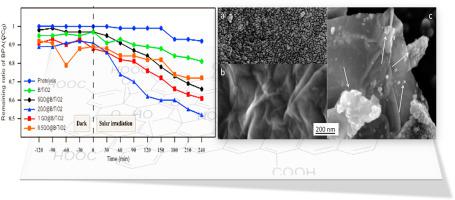当前位置:
X-MOL 学术
›
Mater. Sci. Semicond. Proc.
›
论文详情
Our official English website, www.x-mol.net, welcomes your
feedback! (Note: you will need to create a separate account there.)
Hydrothermal preparation of B–TiO2-graphene oxide ternary nanocomposite, characterization and photocatalytic degradation of bisphenol A under simulated solar irradiation
Materials Science in Semiconductor Processing ( IF 4.2 ) Pub Date : 2021-03-01 , DOI: 10.1016/j.mssp.2020.105591 Ilknur Altin , Xianzheng Ma , Vittorio Boffa , Emin Bacaksız , Giuliana Magnacca
Materials Science in Semiconductor Processing ( IF 4.2 ) Pub Date : 2021-03-01 , DOI: 10.1016/j.mssp.2020.105591 Ilknur Altin , Xianzheng Ma , Vittorio Boffa , Emin Bacaksız , Giuliana Magnacca

|
Abstract Boron-doped TiO2 decorated on graphene oxide photocatalysts (denoted as GO@B–TiO2) were prepared for the effective photocatalytic treatment of bisphenol A (BPA) from water under simulated solar light. To prepare GO@B–TiO2 nanocomposites, B–TiO2 was initially synthesized via a sol-gel procedure and subsequently decorated on graphene oxide at 70 °C, by a facile hydrothermal method. Characterization results show that B–TiO2 particles are anchored on the surface of graphene oxide successfully. Their photocatalytic efficiency could also be adjusted by changing the ratios between B–TiO2 and GO. The optimum GO loading is 2 wt%, at which GO@B–TiO2 nanocomposite photocatalyst could achieve the best BPA degradation percentage of 47.66% compared with B–TiO2 materials (18.78%) after 240 min of solar irradiation. The dominant reactive oxygen species (ROS) formed during the photocatalytic abatement of BPA were determined to be O2.- and .OH. The presence of carbonate and chloride induced moderate inhibitory effect on GO@B–TiO2 (2 wt% GO), while bicarbonate and nitrate displayed only minor effect towards photocatalytic degradation of BPA. Based on these results, the as-prepared nanocomposites may be used as efficient and promising photocatalysts in secondary treatments to degrade recalcitrant contaminants in water exploiting the visible-light region of the full solar spectrum.
中文翻译:

B-TiO2-氧化石墨烯三元纳米复合材料的水热制备、模拟太阳辐射下双酚A的表征及光催化降解
摘要 制备了修饰在氧化石墨烯光催化剂上的掺硼 TiO2(表示为 GO@B-TiO2),用于在模拟太阳光下有效地光催化处理水中的双酚 A(BPA)。为了制备 GO@B-TiO2 纳米复合材料,B-TiO2 最初是通过溶胶-凝胶程序合成的,然后在 70°C 下通过简便的水热法装饰在氧化石墨烯上。表征结果表明,B-TiO2 颗粒成功地锚定在氧化石墨烯的表面。它们的光催化效率也可以通过改变 B-TiO2 和 GO 之间的比例来调整。最佳 GO 负载量为 2 wt%,在该条件下,GO@B-TiO2 纳米复合光催化剂在太阳照射 240 分钟后与 B-TiO2 材料(18.78%)相比,BPA 降解率最高,为 47.66%。在 BPA 的光催化减排过程中形成的主要活性氧 (ROS) 被确定为 O2.- 和 .OH。碳酸盐和氯化物的存在对 GO@B-TiO2 (2 wt% GO) 产生了适度的抑制作用,而碳酸氢盐和硝酸盐对 BPA 的光催化降解作用很小。基于这些结果,所制备的纳米复合材料可用作有效且有前景的光催化剂,用于利用全太阳光谱的可见光区域降解水中顽固污染物的二次处理。而碳酸氢盐和硝酸盐对光催化降解 BPA 的影响很小。基于这些结果,所制备的纳米复合材料可用作有效且有前景的光催化剂,用于利用全太阳光谱的可见光区域降解水中顽固污染物的二次处理。而碳酸氢盐和硝酸盐对光催化降解 BPA 的影响很小。基于这些结果,所制备的纳米复合材料可用作有效且有前景的光催化剂,用于利用全太阳光谱的可见光区域降解水中顽固污染物的二次处理。
更新日期:2021-03-01
中文翻译:

B-TiO2-氧化石墨烯三元纳米复合材料的水热制备、模拟太阳辐射下双酚A的表征及光催化降解
摘要 制备了修饰在氧化石墨烯光催化剂上的掺硼 TiO2(表示为 GO@B-TiO2),用于在模拟太阳光下有效地光催化处理水中的双酚 A(BPA)。为了制备 GO@B-TiO2 纳米复合材料,B-TiO2 最初是通过溶胶-凝胶程序合成的,然后在 70°C 下通过简便的水热法装饰在氧化石墨烯上。表征结果表明,B-TiO2 颗粒成功地锚定在氧化石墨烯的表面。它们的光催化效率也可以通过改变 B-TiO2 和 GO 之间的比例来调整。最佳 GO 负载量为 2 wt%,在该条件下,GO@B-TiO2 纳米复合光催化剂在太阳照射 240 分钟后与 B-TiO2 材料(18.78%)相比,BPA 降解率最高,为 47.66%。在 BPA 的光催化减排过程中形成的主要活性氧 (ROS) 被确定为 O2.- 和 .OH。碳酸盐和氯化物的存在对 GO@B-TiO2 (2 wt% GO) 产生了适度的抑制作用,而碳酸氢盐和硝酸盐对 BPA 的光催化降解作用很小。基于这些结果,所制备的纳米复合材料可用作有效且有前景的光催化剂,用于利用全太阳光谱的可见光区域降解水中顽固污染物的二次处理。而碳酸氢盐和硝酸盐对光催化降解 BPA 的影响很小。基于这些结果,所制备的纳米复合材料可用作有效且有前景的光催化剂,用于利用全太阳光谱的可见光区域降解水中顽固污染物的二次处理。而碳酸氢盐和硝酸盐对光催化降解 BPA 的影响很小。基于这些结果,所制备的纳米复合材料可用作有效且有前景的光催化剂,用于利用全太阳光谱的可见光区域降解水中顽固污染物的二次处理。









































 京公网安备 11010802027423号
京公网安备 11010802027423号